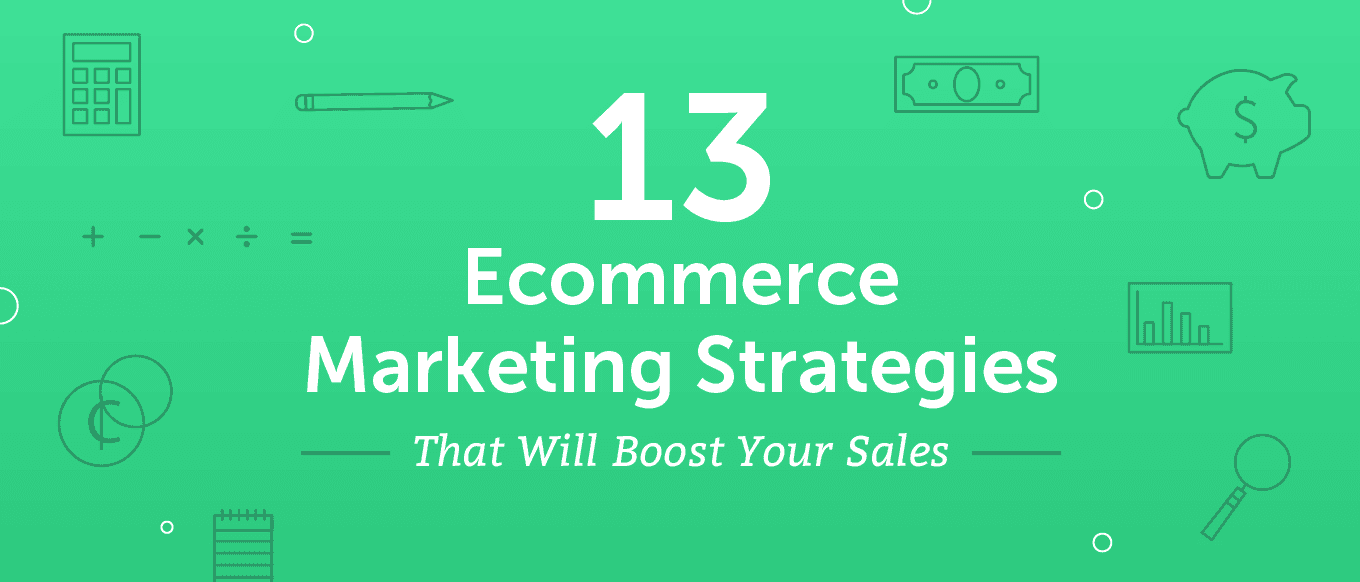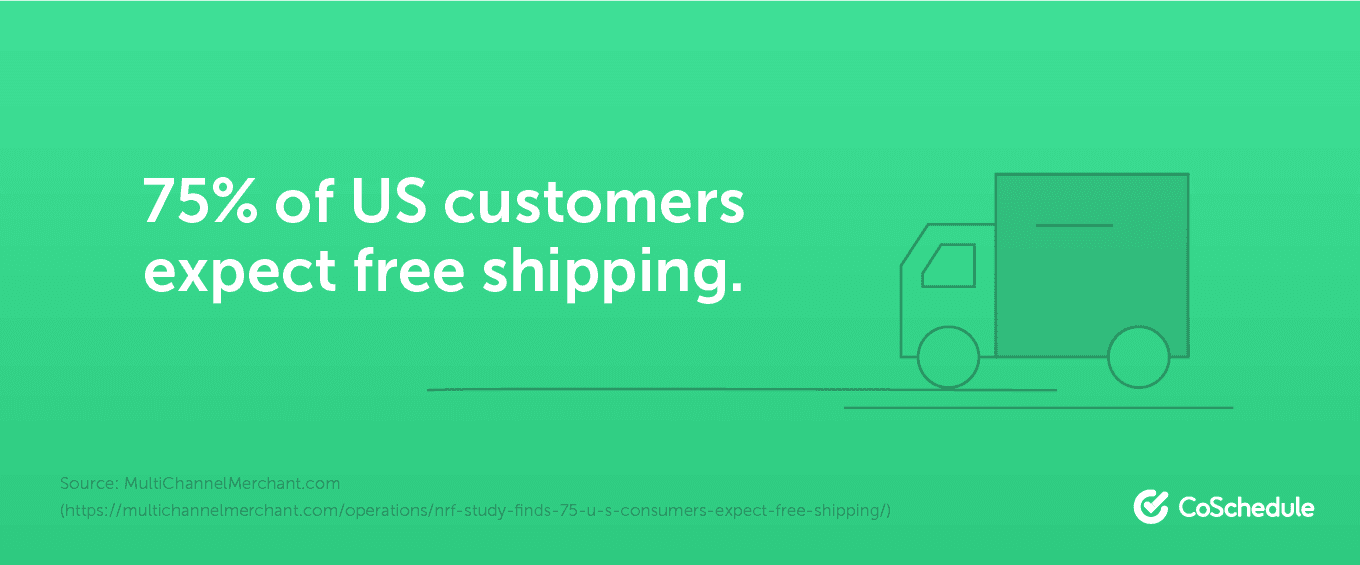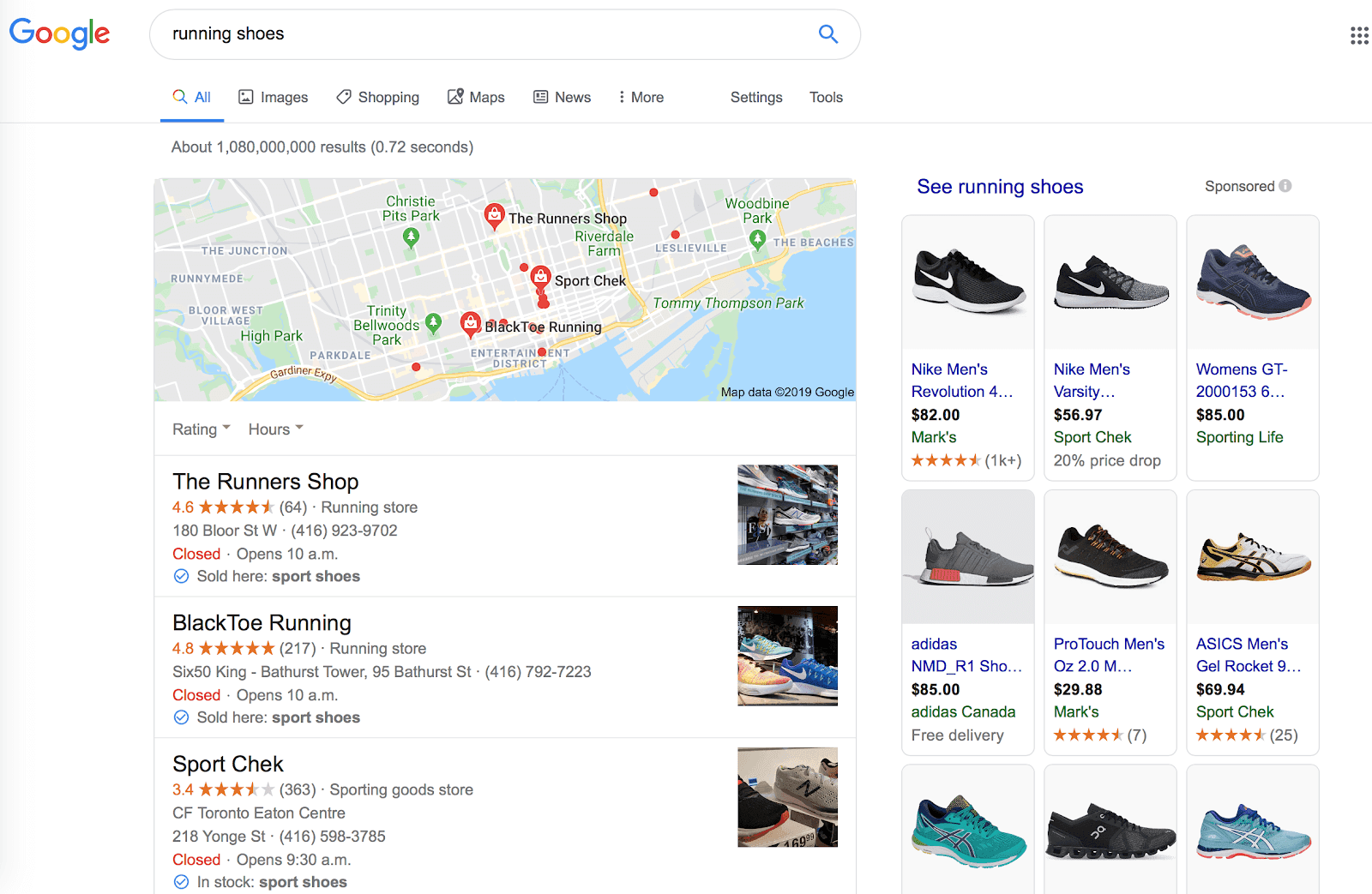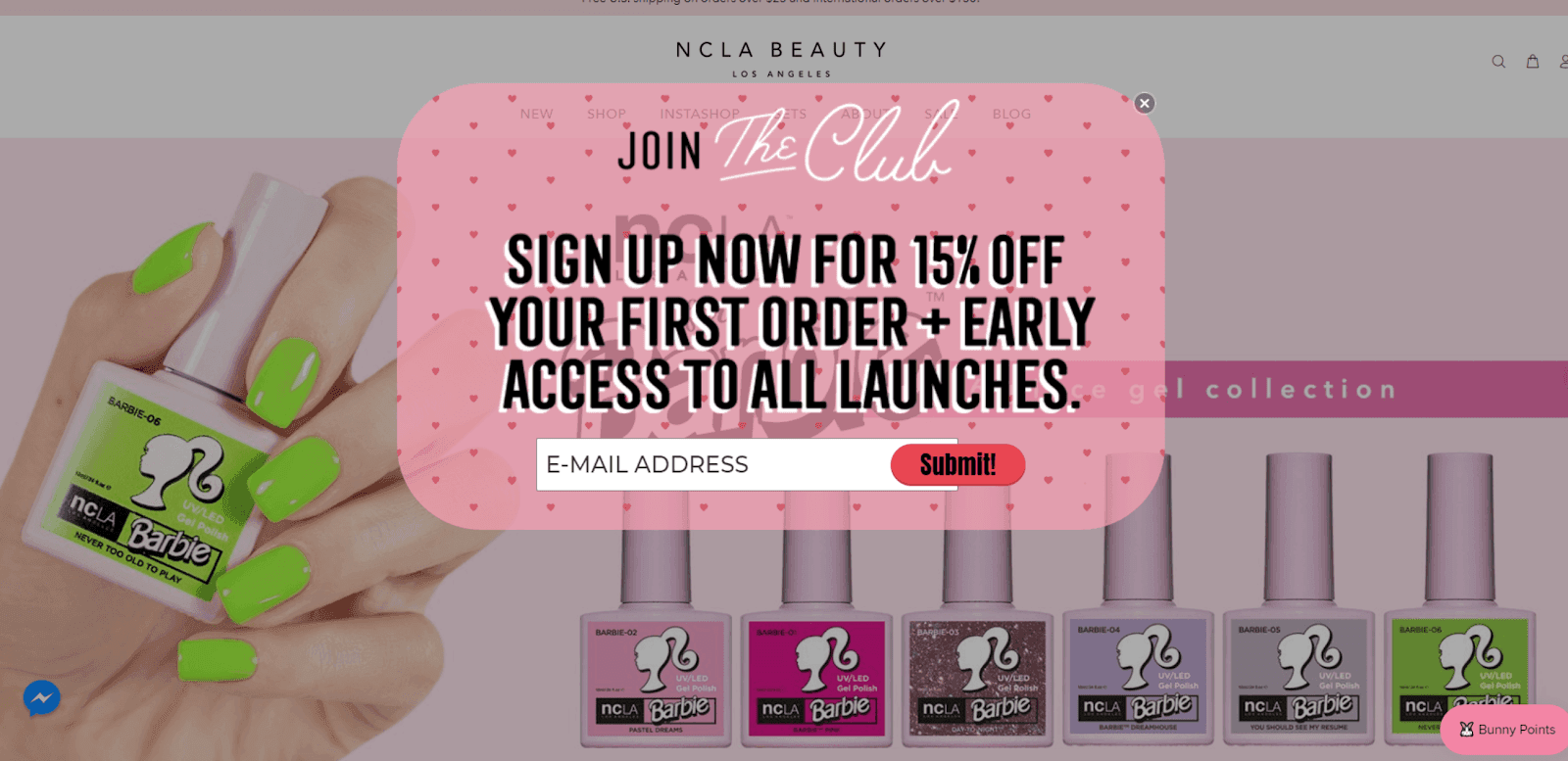13 Ecommerce Marketing Strategies That Will Boost Your Sales
 Are you struggling to pick the best ecommerce marketing strategies that would help you drive traffic, conversions, and sales?
Do you feel stuck about where to begin to increase your sales further?
Marketing is among the very first things you consider when launching an Ecommerce store. Once you’ve selected what products you want to sell, you begin to wonder how to drive more traffic to the site, and convert it into sales.
But, as even many seasoned ecommerce owners will attest, figuring it out is quite a challenge.
You have, possibly, hundreds of different strategies at your disposal to attract more people to your site. Unless you do the right ones, all your efforts will be in vain.
So, how do you choose? How do you decide which marketing strategies will work best for your online store?
Well, you can use this post for guidance, for once.
Not only we’ve listed 13 of the absolute best ecommerce marketing strategies, but we’ve also organized them in the order you should be implementing them if you were to start your marketing today.
We begin with marketing planning and present you with more and more advanced strategies as we move along.
Interested in boosting your store’s traffic and sales? Buckle up, and let’s begin.
Are you struggling to pick the best ecommerce marketing strategies that would help you drive traffic, conversions, and sales?
Do you feel stuck about where to begin to increase your sales further?
Marketing is among the very first things you consider when launching an Ecommerce store. Once you’ve selected what products you want to sell, you begin to wonder how to drive more traffic to the site, and convert it into sales.
But, as even many seasoned ecommerce owners will attest, figuring it out is quite a challenge.
You have, possibly, hundreds of different strategies at your disposal to attract more people to your site. Unless you do the right ones, all your efforts will be in vain.
So, how do you choose? How do you decide which marketing strategies will work best for your online store?
Well, you can use this post for guidance, for once.
Not only we’ve listed 13 of the absolute best ecommerce marketing strategies, but we’ve also organized them in the order you should be implementing them if you were to start your marketing today.
We begin with marketing planning and present you with more and more advanced strategies as we move along.
Interested in boosting your store’s traffic and sales? Buckle up, and let’s begin.
13 Ecommerce Marketing Strategies That Will Boost Your Sales
Click To TweetDOWNLOAD: Ecommerce Marketing Project Calendar
When it's time to execute your strategy, help manage projects with this ecommerce content calendar template. It includes simple fields to list each project you'll work on and assign due dates so your team can keep organized, hit deadlines, and ship more work:#1. Define Whom You Want to Attract in the First Place
Every marketing strategy must start with solid market research about the very people you want to engage - your target audience. However, in my experience of working with online retailers, I noticed how rarely those people actually do it! Now, in truth, most of those store owners would have a good idea about their ideal client base. They know who needs their products, and why. Unfortunately, to drive marketing strategies, you need to know much more about them. You should know what ideal clients think of products like yours, how do they speak of them or even how they might be referring to them and more. Then, you also need to know how they look for information relevant to the product, their lifestyle, drivers behind their decisions, and more. Why, because having a clear picture of the target audience drives most of your marketing:- It helps you make the website copy more relevant to the clients’ needs,
- Improves audience communications, and allows you to interact with the customers in a relevant and engaging manner,
- It reveals where you should market the business to get in front of your ideal buyers and more.
#2. Define Your Value Proposition
According to the company’s most recent data, there are half a million online stores running on Shopify alone. That’s 500,000 of potential competitors of yours on a single ecommerce platform only! What about those running Magento, BigCommerce, Woocommerce or some custom software? The total number would most likely make anyone dizzy. But that’s also the reality you have to run your store in. Ecommerce is a competitive market. Potentially, many other stores target the same audience as you. How do you ensure that customers notice your company, and consider buying from you? The answer, by standing out. Enter the Unique Value Proposition (UVP). CoSchedule created a fantastic definition of the UVP, calling it: “...the core benefit or solution that differentiates your product or service from the competition and positions it as the best possible solution on the market.” In short, the UVP tells customers why they should consider buying from you.
There are many different types of UVPs in ecommerce. The most common is a lower price, although I think we can both agree, it’s never the best option.
The other possible UVPs include:
In short, the UVP tells customers why they should consider buying from you.
There are many different types of UVPs in ecommerce. The most common is a lower price, although I think we can both agree, it’s never the best option.
The other possible UVPs include:
- Offering free shipping if your competitors don’t or faster delivery times,
- Having a better return policy,
- Offering reward points for purchasing at your store,
- Having a better customer service (and being able to prove it), and much more.
#3. Evaluate the Competition
Speaking of the competition - Other stores in your niche could help power your marketing and sales too. The chances are that those companies have been doing it for much longer than you, and have tested many strategies you haven’t even considered yet. Analyzing how they work, what factors drive their success, and how they engage the audience could help inform many of your decisions.#4. Work Out Possible Offers
Most ecommerce customers expect you to offer them something for buying on your store. According to the National Retail Federation, 75% of US customers expect free shipping. Many also assume that a brand will offer a discount, coupon code or another incentive to make the purchase. Unfortunately, you can offer only some incentives. Well, you can’t if you want to make any profit at all, that is.
So, as you’re preparing to launch your first marketing strategies, consider what offers you can afford, and make them the center of your marketing.
Unfortunately, you can offer only some incentives. Well, you can’t if you want to make any profit at all, that is.
So, as you’re preparing to launch your first marketing strategies, consider what offers you can afford, and make them the center of your marketing.
#5. Review Your Marketing Efforts So Far
Even if you run a relatively new store, you, most likely, have done some marketing. Perhaps you don’t run any extensive advertising campaigns and your SEO is still lacking but you may have emailed some friends, family or people you know about the store. You may have some social media presence and have even gained some initial followers. The chances are that you also added the store to some ecommerce directories or have mentioned it on an industry forum or so. Granted, these activities, possibly, haven’t delivered much return yet. But they could tell you something about your audience already. Review any traffic you’ve received from those emails or any other activities have attracted. Analyze your social media engagement. You may discover initial nuggets of information to drive your proper marketing strategies:- You may notice that followers on social media respond to specific topics better than others. Even if that engagement is minimal, you can still use it as an important signal.
- Traffic from forums may have stayed longer than other visitors, suggesting a good interest in the product, and so on.
#6. Review Your Audience’s Interests
One of the common mistakes in ecommerce marketing is focusing on the bottom of the funnel only. Online retailers target customers ready to buy, forgetting about attracting those only browsing potential products to buy to develop business relationships with them. And yet, only about 17% of customers browse the web with the intention to buy right now. Based on such data, we can safely assume that if you focus on that group only, you’ll, most likely, miss out on engaging 83% of customers.
Based on such data, we can safely assume that if you focus on that group only, you’ll, most likely, miss out on engaging 83% of customers.
 But how could you engage those people anyway? Your business sells products, after all, all the while they are not interested in buying anything yet…
That’s where content comes into play. Content will attract top of the funnel visitors, providing you share information they care about, of course. The same goes for social media content and other strategies.
And to know what those topics are, you must research your audience’s interests.
Such knowledge will drive many of your top of the funnel strategy:
But how could you engage those people anyway? Your business sells products, after all, all the while they are not interested in buying anything yet…
That’s where content comes into play. Content will attract top of the funnel visitors, providing you share information they care about, of course. The same goes for social media content and other strategies.
And to know what those topics are, you must research your audience’s interests.
Such knowledge will drive many of your top of the funnel strategy:
- It will inform what content types you’ll focus on - blogs, videos, short content, etc.
- Knowing the audience’s interests will also help you curate social content better for them.
- You’ll know what contests and other viral marketing strategies, as you’ll know what your potential customers will respond to the most.
#7. Conduct In-Depth Keyword Research Based on the Audience’s Preferences
We all search with keywords. It doesn’t matter whether we’re trying to find gift ideas or seek the best place to buy the item we want, the process is pretty much the same. We type a phrase we think best describes the information we’re looking for into Google, and scout the SERP page for the results that promises to deliver it the most. Which means that, to win at marketing, you must know what topics your audience is looking for, and, what intent do they have when conducting the search. This last bit is particularly important so, let me explain. Keyword research has changed tremendously over the last few years. In the past, Google couldn’t understand complex queries well enough, forcing us to using predictable phrases to describe the object of our search. When looking for running shoes, we’d type “running shoes” into the search box. Today, however, Google is smart enough to understand queries it has never seen before. We can search for “what do you wear for running” and the search engine will return relevant information. As a result, as customers, we can search using any keyword we like. Unfortunately, for us, marketers, this means that predicting how someone is going to find our store is pretty much impossible. Enter topics. Topics define your customers’ key area of interest. They might use their own, unique queries to look for information on the topic, but what’s important is that they do research it in the first place. Much of your keyword research strategy should relate around identifying those topics. These could be as generic as your product categories or go deeper into different aspects of the topic. Only when you have those, conduct keyword research within the topic to identify common phrases and their variations to use in the content. Check this guide to keyword research to see how the complete process looks like.#8. Map and Optimize Website Content for the Right User Intent
Another major aspect to keyword research you must know about is the user intent. The user intent is nothing else that a reason why someone has requested certain information from Google. Typically, users exhibit one of four intents: They either want to learn something, go to a specific website, research potential purchase or buy something. Why is understanding the search intent behind a keyword important? Well, it’s simple, actually. Google wants to deliver the most relevant results to its users. This means that, it will choose content that matches the intent closely (as it is the most likely to deliver on the user’s expectations.) So, to rank, your pages - be it product pages, informational content or blog posts - must match the specific user intent for their target queries. There is another reason for mapping your pages to the right intent. Doing so will eliminate the risk of having the wrong page type ranking for a keyword. Commonly, stores struggle with blog content ranking for phrases a product page would suit better. Mapping content and keywords to the right intent will ensure that your informational content will not compete with commercial pages and vice versa. The good news is that identifying the intent isn’t that tricky. At the most basic level, you could just put your target keyword into Google and see what type of information pages listed their offer. For instance, researching “running shoes” delivers mostly commercial results. What’s more, the top of the SERP page contains a local pack with stores offering such a product. Based on this simple fact, I can assume that anyone typing a similar phrase into Google wants to purchase running shoes and do it at their local store. On the other hand, searching for “running winter” lists information and tips for jogging in the winter season, suggesting a completely different intent for that phrase.
On the other hand, searching for “running winter” lists information and tips for jogging in the winter season, suggesting a completely different intent for that phrase.

#9. Develop a Lead Generation Strategy
Remember what we said about your funnel? Only 17% of visitors are ready to buy on their first visit. The rest, most likely, still conducts research and decides which product to buy and where. We spoke about the importance of attracting those customers to the site too already. Now, let’s cover the next step in the process - Converting them into an email list. The importance of email in the ecommerce marketing is irrefutable. The strategy is more effective than most other channels at bringing sales and ROI. The thing is, you can’t use it without an email list filled with addresses of current customers, leads, and prospects. How do you collect them? There are many strategies that could help. Most revolve around placing relevant offers and calls to action throughout the site. However, there is one particular strategy that works better than anything else - Popups. Pop Ups, as the name suggests, are offers that literally pop up on the screen at a predefined time to engage visitors. Pop Ups can help build your list but also, recover abandoned carts and even convince undecided customers to make a purchase.

 (Check this page for more Shopify popups to inspire your strategy. These examples will work for any store to drive traffic and signups.)
And they do it so well.
Our customers, for example (note, I work for a company offering popup software,) see conversion rates up to 15% from their popups. On average, online stores convert up to a staggering 3.75% of their visitors with the strategy.
A lot goes into a successful popups campaign. Luckily, CoSchedule posted an amazing guide to building an email list with all the info you need. Check it out!
(Check this page for more Shopify popups to inspire your strategy. These examples will work for any store to drive traffic and signups.)
And they do it so well.
Our customers, for example (note, I work for a company offering popup software,) see conversion rates up to 15% from their popups. On average, online stores convert up to a staggering 3.75% of their visitors with the strategy.
A lot goes into a successful popups campaign. Luckily, CoSchedule posted an amazing guide to building an email list with all the info you need. Check it out!
#10. Build Deep Connections with Your Audience on Social Media
Customers want deeper connections with brands, and building those pays off for you too. According to Adweek, 71% of customers who feel such a connection to a brand spend twice as much as those who don’t. Other research proves that customers use social media to discover new products, conduct brand research, and get customer support too.
Customers want to be entertained on social media too. According to the GlobalWebIndex, filling up spare time and entertainment are the 3rd and 4th reason respectively why people use social media.
Much of your ecommerce social media strategy, therefore, should revolve around entertaining followers, with a touch of product advertising and promotion.
Other research proves that customers use social media to discover new products, conduct brand research, and get customer support too.
Customers want to be entertained on social media too. According to the GlobalWebIndex, filling up spare time and entertainment are the 3rd and 4th reason respectively why people use social media.
Much of your ecommerce social media strategy, therefore, should revolve around entertaining followers, with a touch of product advertising and promotion.
#11. Generate Buzz with Contest Marketing
Contests help online stores attract more social followers, build the email list, build a community, brand awareness and more. Contests are viral and can spread like wildfire, promoting your brand to people who might have never heard of it otherwise. There are even some amazing stats to prove it:- Contests convert at around 34%, typically. That’s far above any other content type.
- Almost all users share the promotion after participating in it themselves.
- 62% will share it with a friend and suggest they take part too.
 One of the key reasons why they work is because they’re fun. The fact that participants can win prizes is also a nice bonus, of course.
But social contests are also hard to set up, sadly. Given the amount of noise on the web already, they must truly stand out to generate the results you seek.
(That’s one reason why I’ve included them at the end of this list, suggesting simpler ecommerce marketing strategies beforehand.)
However, if you’re not afraid of putting in some work and dedicating resources to setting up and running a social contest, I strongly recommend that you do.
There are three main types of ecommerce contests:
One of the key reasons why they work is because they’re fun. The fact that participants can win prizes is also a nice bonus, of course.
But social contests are also hard to set up, sadly. Given the amount of noise on the web already, they must truly stand out to generate the results you seek.
(That’s one reason why I’ve included them at the end of this list, suggesting simpler ecommerce marketing strategies beforehand.)
However, if you’re not afraid of putting in some work and dedicating resources to setting up and running a social contest, I strongly recommend that you do.
There are three main types of ecommerce contests:
- Sweepstakes
- Competitions
- Lotteries
#12. Reach New Customers with Referral Marketing
Crazy, isn’t it? 82% of customers consult their friends and family before making a purchase. That means that you’d be super likely to increase sales if only you could find a way to convince those friends and family to recommend your product, right?
Well, you can. This marketing strategy is called referral marketing. In a nutshell, it aims to entice current customers to refer your store or products to the people they know.
(Oh, and if you’re not convinced that you do need a referral marketing strategy consider this - Although 83% of customers are happy to refer a product they liked to others, only 29% actually do that on their own accord!)
Typically, referral marketing focuses on offering some sort of incentive to a customer for making a referral.
The most common incentives include a store credit, discounts or product samples.
Once again, referral marketing isn’t easy. Not only you need the right incentive. You also need the right way for customers to refer the product - via email, social media, etc. You also need a way to track those referrals so that you can reward referring customers.
But it’s damn worthy of doing.
According to Ambassador, referrals generate $155k in revenue in ecommerce and retail annually.
That means that you’d be super likely to increase sales if only you could find a way to convince those friends and family to recommend your product, right?
Well, you can. This marketing strategy is called referral marketing. In a nutshell, it aims to entice current customers to refer your store or products to the people they know.
(Oh, and if you’re not convinced that you do need a referral marketing strategy consider this - Although 83% of customers are happy to refer a product they liked to others, only 29% actually do that on their own accord!)
Typically, referral marketing focuses on offering some sort of incentive to a customer for making a referral.
The most common incentives include a store credit, discounts or product samples.
Once again, referral marketing isn’t easy. Not only you need the right incentive. You also need the right way for customers to refer the product - via email, social media, etc. You also need a way to track those referrals so that you can reward referring customers.
But it’s damn worthy of doing.
According to Ambassador, referrals generate $155k in revenue in ecommerce and retail annually.
 Source: https://www.getambassador.com/blog/b2b-referral-program-effectiveness
Source: https://www.getambassador.com/blog/b2b-referral-program-effectiveness
#13. Get Influencers on Board
This is by far the most challenging ecommerce marketing strategy of all. It revolves around engaging influencers and getting them to promote your product to their audiences. BigCommerce defined influencer marketing as a strategy when:“[...] companies partner with influencers in order to increase brand awareness or conversions among a specific target audience.”But why is it so challenging? Well, first of all, getting influencers to even agree to consider your product is tricky. These people know their worth and guard their audiences closely. The strategy is not cheap either. Experts predict that influencer marketing will become a $5-$10Bn market by next year. But it’s so darn worth it too. 89% of brands say that the ROI from the strategy is comparable or better than what they get from other channels.
 It’s no surprise that 17% of companies spend half of their entire marketing budget on influencers.
How do you get started?
Well, as said, the strategy is not easy. Luckily, CoSchedule has outlined some steps you need to implement it on Instagram.
Good luck!
It’s no surprise that 17% of companies spend half of their entire marketing budget on influencers.
How do you get started?
Well, as said, the strategy is not easy. Luckily, CoSchedule has outlined some steps you need to implement it on Instagram.
Good luck!

